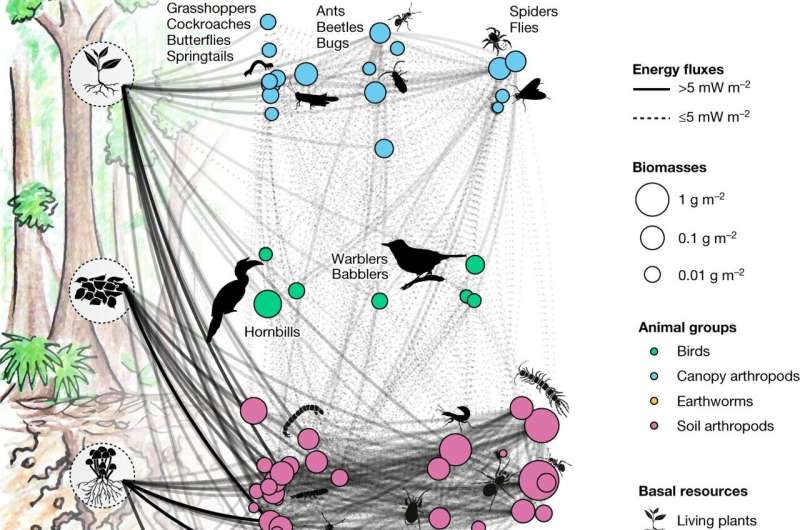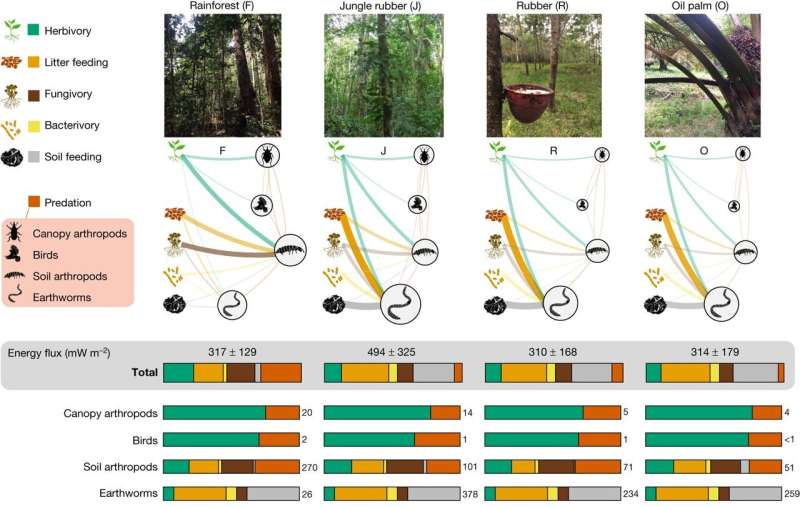This article has been reviewed according to Science X's editorial process and policies. Editors have highlighted the following attributes while ensuring the content's credibility:
fact-checked
trusted source
proofread
Converting rainforest to plantation impacts food webs and biodiversity, study finds

The conversion of rainforest into plantations erodes and restructures food webs and fundamentally changes the way these ecosystems function, according to a new study published in Nature. The findings provide the first insights into the processing of energy across soil and canopy animal communities in mega-biodiverse tropical ecosystems.
Every day, new areas of rainforests are converted into plantations, drastically changing tropical biodiversity and the way the ecosystem functions. Yet, the current understanding of the consequences is fragmentary: previous studies tended to examine either biodiversity or the ecosystem.
An international research team led by the universities of Göttingen in Germany and Bogor in Indonesia in collaboration with the German Center for Integrative Biodiversity Research (iDiv) and Leipzig University (UL) brings these threads together in this study. They analyzed organisms ranging from microscopic mites and earthworms in the soil, to beetles and birds in tree canopies, comparing tropical rainforest with rubber and oil palm plantations in Sumatra, Indonesia.
The researchers set out to study both biodiversity—plants, insects, vertebrates—and changes in how food webs function—biomass, trophic structure, energy fluxes.
To do this, they estimated the abundance and biomass of the following: arthropods (such as spiders, insects, mites and centipedes) in the tree canopies using a technique known as "fogging"; birds using audio recorders and observation at specific points; and soil arthropods and earthworms from soil cores. This information was collected across 32 sites representing rainforest or plantations.
They analyzed their findings using existing models on traits and feeding preferences to reconstruct food webs at each site and across all animal groups.

The results were used as measures of the distribution of energy and consumption of different resources (living plants, litter, bacteria, fungi, soil organic matter, other animals) in food webs above and below the ground. This method takes into account decomposition and quantifies the actions of predators (such as certain spiders or birds) in food webs.
The scientists identified that most energy in rainforest animal communities flows to arthropods in soil food webs. Plantations, by contrast, had a very different energy distribution: food webs in canopies were less rich and less complex, and food webs in the soil were also changed.
Instead of diverse arthropod communities, virtually all energy was allocated to invasive species of earthworms. Because of these changes, there was generally little predation and relatively high numbers of plant feeding insects (such as caterpillars and beetles) in plantations.
"It is fascinating to see how all these different organisms are connected, from minute arthropods to birds, from soils to canopies. Scientists clearly need to investigate such connections in different parts of the ecosystem, particularly endangered areas of biodiversity—such as the one beneath our feet," said Anton Potapov, first author of the study, who was at the University of Göttingen during the data collection and later headed the junior research group Biodiversity and Soil Functions at iDiv and UL.
"The ongoing conversion of rainforest into plantations is not just causing a massive decline in biodiversity, but it is also changing the way these ecosystems function," explains Professor Stefan Scheu, senior author and head of Animal Ecology, University of Göttingen.
"For sustainable management of converted ecosystems, we need to understand how all these linked elements and connections are impacted. A more holistic approach can then be developed to promote the functioning of ecosystems both above and below ground."
More information: Anton M. Potapov et al, Rainforest transformation reallocates energy from green to brown food webs, Nature (2024). DOI: 10.1038/s41586-024-07083-y




















